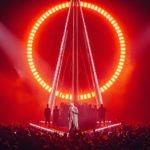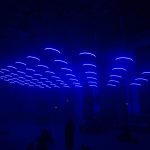“No man is happy without a delusion of some kind. Delusions are as necessary to our happiness as realities.” – Christian Nevell Bovee, author/lawyer
If ever you feel like the deposits in your self-esteem account are outpacing your withdrawals, you might consider letting your significant other loose with your ego credit card. That should take care of any excess balance you might have.
I only say that because it’s true. And I know that because of last Sunday. That was the day of an event in which I was fortunate enough to be involved in as a consultant working with several people on the production design. It was a massive event, Resurrection Day at Minute Maid Park in Houston, where 32,000 people came together to celebrate a special day. It was a challenging event in that the stages were to be placed on a baseball field, but it couldn’t touch the grass. Nor could any of the crew touch the grass.
It’s been a long time since I actually went to a baseball game, but I seem to recall that a large majority of it is actually played on the grass. In fact, I think that very little of the field is not grass. It’s that “not grass” part that onto which we had to place a massive stage for 50 pieces of orchestra, several dignitaries, 600 people in blue and white robes (a.k.a. the choir), and a few talented folks like Clay Walker, CeCe Winans and Wintley Phipps.
From the start, we knew that there would be a live audience, but we also knew it was going to DVD. Having little experience with set design and broadcast events, I was looking for a big name designer to work with. So I called up lighting designer Chas Herington (www.zenithlighting.com) and asked if he knew any. Actually, Chas has a lot of experience with video and film and I think he’s one of the most talented designers I know. He and I also brought in Bill Strother (www.williamstrother.com), who is a very talented set and lighting designer. Together, we worked with technical director Mark Sepulveda, director Amanda Raska, video director John Pembroke and lighting director Richard Blankenship, all from Second Baptist Church in Houston, which was hosting the event.
Our biggest concern was to make the video pictures look good, so we were very concerned about the close-ups and wide shots. We were also told that they didn’t want a “rock concert,” but they wanted a conservative look. They had done last year’s event in the Toyota Center, so they had definite ideas about what they wanted. One of them was a good background for the cameras, especially when the pastor was on the pitcher’s mound delivering the message. They had their in-house graphics department work up a design for four massive banners, each 10 feet wide and 30 feet tall. They were working on a stained glass image and they planned to place them across the centerfield warning track (which is not grass!) so they would be visible but slightly out of focus.
Another idea that Mark had was to plaster the ceiling of Minute Maid Park with projections of stained glass images. We discussed various ideas including using the biggest video projectors we could find, automated lighting, Pani or Pigi projectors or a fleet of Robert Juliat followspots with stained glass gobos. But we were working in some very challenging conditions because the roof is somewhat translucent and one side of the stadium has enormous windows. The event was to be from 9 a.m. to noon—broad daylight in Houston in the spring, meaning major ambient light. We decided to take a chance and rent 18 Syncrolite SXB 7,000-watt xenon automated lights with scrolling colors and gobos. We crossed our fingers that they would read on the ceiling. If all else fails, we thought, at least they will look good on camera, especially in the wide shots with star filters in the cameras.
From the beginning, Chas immediately started thinking from the perspective of the camera. What would it see during the closeups? What would be in the background for the money shot (pastor on the mound)? We didn’t like the answer, which was black skirting on the face of the 4-foot-high stage, the legs of the dignitaries, the skirts of the dignitaries! Yikes! That started us thinking about designing some set pieces for the stage to act as a background for the close-ups.
The first pass at a set design was immediately nixed. It was too gothic with too much religious symbolism. They wanted something more abstract. The clock was ticking and the set pieces still had to be built and shipped to the site. We opted to go with the same stained glass design they came up with for the banners. In the end, it was a good decision because it circumvented all the approvals and saved precious time. Bill quickly rendered it to scale in Studio Max, and I took his design and created a 3-D model of the stadium, the stage, the set pieces and the banners in CAD. We added some 9-foot columns to give the whole scene perspective and depth, and then we sent it off for approval. When the approvals came back, we pulled the trigger—money changed hands and TW Design in Dallas spent the weekend building and painting three tri-panel screens, each 9 feet high and 9 feet wide.
The lighting vendor, LD Systems, picked up and delivered the Syncrolites, the tripanels and the columns. When I walked on-site Saturday morning, Brent Sanders, the programmer from LD Systems, had all the fixtures up and working and beaming onto the ceiling of Minute Maid. The problem was, I should have noticed them when I walked in, but the ambient light was just too much, even for 7K lights. When Mark pointed them out to me, my heart sank.
But it didn’t take long for me to realize that they added a much-needed dimension to the event. When I got a video monitor and switcher at the lighting FOH and I saw the first pictures, I was relieved. It looked great. Brent programmed some very tasteful sweeps and color changes and it justified, at least in my mind, the expense of the fixtures. It wasn’t trivial.
The crew was busy making last minute preparations—setting up chairs on the stage, running cables everywhere, tweaking the audio. After sitting with Brent for an hour or so, I turned my attention to the set pieces. The prior Wednesday, Mark had called me and said the AutoCAD drawing of the stadium that we had been given didn’t match the real thing, and we lost a lot of the precious dirt on the downstage edge. Since that was where we had planned to put the main set piece, our background was in jeopardy. It was decided that we would have to build a bridge across the grass in order to place the set piece in front of the stage. We also had to set it up during a transition in the show and take it back down after the message was delivered. Otherwise, it would interfere with the sight lines to the main stage. We had discussed several options to automate it, but we didn’t have the time or money to deal with it. So we settled on manpower (or womanpower) to get it in and out of place. But given the very limited space we had for it, it was going to be a challenge.
Just before the first dress rehearsal, we found out that they had to put stairs on the downstage edge to allow the dignitaries to get up and down the stage with their dignity. That meant there was no room for the main set piece and it was struck. Ouch.
In the end, we had a beautiful set with a magnificent stage, majestic-looking columns, nice stained-glass windows seemingly floating in mid-air behind the robed songbirds and some beautiful pictures on video. It wasn’t quite what we had in mind when we were drawing it up, but sometimes you have to make do with what you can get away with.
On show day, I sat in the dugout watching the monitor and surveying the live scene. My wife and daughter made the trip to Houston, and at one point, I made my way up to the arena level where they were sitting. I proudly pointed out the 18 Syncrolites, the six columns and the two set pieces, indicating our involvement.
I believe her exact response was, “It took three of you to come up with six columns and two set pieces? What’s that, two columns apiece?”
My wife has a way of keeping my ego in check. It’s called reality.
Is this thing on? Send your feedback to the author at rcadena@plsn.com.


